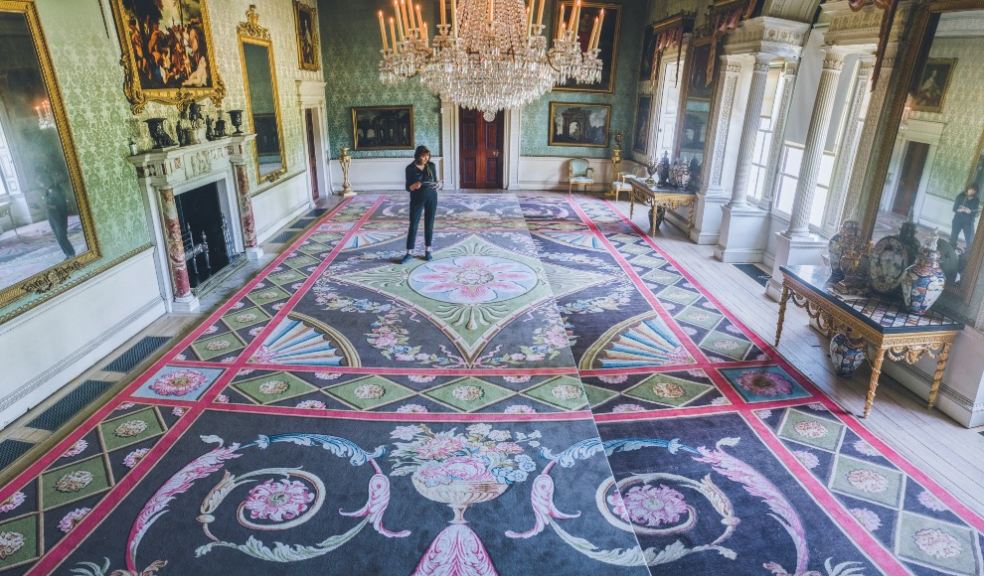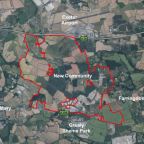
Visitors to one of UK’s finest Georgian interiors can experience it as it was intended after ‘complex’ reweave of National Trust’s most important carpet
For the first time in more than 40 years, visitors can enjoy one of Britain’s finest early Georgian interiors as its designer intended, after its spectacular Axminster carpet – the most significant in the National Trust’s care – was recreated by the firm whose founder wove the original in the same Devon town in 1770.
Historic local firm Axminster Carpets rebuilt its largest loom to enable the weave, the most complex commission it has undertaken in its 268-year history.
John and Theresa Parker asked the fashionable Scottish designer and architect Robert Adam to design every detail of the Saloon at Saltram, near Plymouth, in around 1768. He designed a huge 13.5m x 5.9m one-off carpet to echo the pattern of the exquisite plasterwork ceiling above, with festoons of flowers and ribbons, bands of diamonds and fans in pinks, blues, browns and greens.
But for decades, visitors have been unable to appreciate Adam’s no-expense-spared interior scheme as it was meant to be, or to see the details and artworks in an elegant, harmonious whole.
Curator Zoe Shearman said: “For a long time the fragility of the carpet stopped visitors from entering all but the edges of the room. Rolling one end protected the carpet but meant people were passive observers of the room and could not see the carpet in its entirety.
“Then, we commissioned a drugget, a protective floor covering for part of the space. This allowed visitors to walk the length of the room but obscured the beautiful central medallion of the carpet’s design.”
Now, the Trust has worked with Axminster Carpets, whose founder, Thomas Whitty [1], wove the original carpet in the 18thcentury, to reweave two partial copies that can be laid over the original. These will allow visitors to enter and appreciate the lavish room as John and Theresa Parker did, while protecting the precious carpet.
The full-length protective reweaves, each covering two-thirds of the carpet’s width, will be regularly rotated. Initially, one copy will be placed along the fireplace wall; after 18 months to two years, it will be cleaned, repaired and stored by bespoke flooring specialists Linney Cooper and the second copy will be laid along the opposite wall. This approach will allow the original carpet to rest and extend the life of the reweaves to up to 30 years.
Following the reweave, people can get up close to artwork and furniture that for many years could only be seen from a distance, including paintings by Sir Joshua Reynolds, a suite of Chippendale gilt and silk armchairs and sofas and an early 17th century copy of Titian’s painting The Andrians, said to have been bought by Joshua Reynolds for the family.
Zoe continued: “The Saloon was part of a scheme of fashionable improvements at Saltram, a space for extravagant entertaining, laughter and making social and political connections. And the carpet was at its heart, with the chairs, tables and torchères all arranged around the edges to allow the 3D-effect of the design to really shine.
“It wasn’t until the 1750s that carpet factories were set up around London and in Axminster, providing wealthy homes with warm, colourful and luxurious floor carpets. With its sheer size, beauty and novelty, the Saltram carpet must have been a truly impressive sight – and it still is today.”
Axminster Carpets’ six-week reweave involved 22 thread colours and 96,130 changes of bobbin (the cylinder on which the yarn is wound), each change taking from three hours to one day to complete.
Axminster Carpets’ Design and Innovation Director Gary Bridge said: “Building the 15ft loom was a huge task that took 20 months. It is the largest 8-pitch mechanical loom in existence, allowing for a fine, detailed weave on a great scale.
“In more than 40 years in the industry, this is the most complicated weave I have ever worked on – and I believe the most complex ever attempted.”
Most of the wool was British, specially dyed to give an appropriate antique appearance. Gary and his team made more than 50 visits to Saltram to check thread colours against the original carpet.
Zoe said: “The original carpet was woven at Thomas Whitty’s Axminster factory, probably by his wife and children, who would have sat alongside each other as they hand-knotted the wool. Because of its size and complexity – with its many decorative motifs – we think it took about a year to complete.
“We’re very grateful to the teams at Axminster Carpets and Linney Cooper, whose expertise in design, hand-finishing, installation and ongoing care has enabled us to complete this once-in-a-lifetime project.”
The carpet reweave is the final stage of a major Saloon conservation project which began in 2017 and gave visitors the opportunity to watch the work in-situ. This included cleaning and consolidating the plaster ceiling by Cliveden Conservation and cleaning and repairing the original carpet, undertaken by a team of local textile conservators. The conservation project was funded by the National Trust and the Wolfson Foundation.
Zoe concluded: “We know that John and Theresa Parker were discerning patrons who collaborated with the finest artists and craftspeople and expected the highest standard of design and quality. The carpet and room as a whole were once enjoyed only by the fortunate few, but we’re proud that now everyone who visits us can see the Saloon back to its Georgian splendour.”
For more information about Saltram, visit nationaltrust.org.uk/saltram














